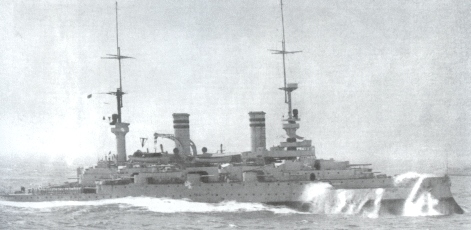German Pre-Dreadnought Battleship SMS Kaiser Wilhelm der Grosse
SMS Kaiser Wilhelm der Grosse was the third ship of the Kaiser Friedrich III class of pre-dreadnought battleships built for the Imperial German Navy (Kaiserliche Marine) in the late 19th century. It was named after Emperor Wilhelm I who was also known as “Wilhelm the Great”.
SMS Kaiser Wilhelm der Grosse was laid down at the Germaniawerft shipyard in Kiel in 1898, launched on 1 June 1899, and commissioned into the fleet on 5 May 1901.
Upon commissioning, Kaiser Wilhelm der Grosse joined the German Home Fleet (Heimatflotte), serving primarily as a unit in the line of battle. Like her sisters, she participated in fleet exercises, training cruises, and diplomatic port visits, helping to showcase the modernizing German Navy under Admiral Alfred von Tirpitz.
Although well-armed and heavily armoured for her time, the rapid pace of naval innovation soon overtook her capabilities. The 1906 launch of HMS Dreadnought revolutionised naval warfare, rendering all existing battleships including Kaiser Wilhelm der Grosse obsolete almost overnight.
By 1908, she was removed from front-line service, placed in reserve, and used for training and support roles.
World War I
When World War I began in 1914, Kaiser Wilhelm der Grosse and her sister ships (SMS Kaiser Friedrich III, SMS Kaiser Wilhelm II, SMS Kaiser Karl der Grosse and SMS Kaiser Barbarossa) were briefly reactivated as part of the V Battle Squadron (V. Geschwader). However, they were quickly deemed unsuitable for modern naval combat due to their relatively slow speed, outdated armament, and vulnerability to torpedoes.
By 1915, she had been disarmed and reassigned as a harbour ship and accommodation vessel, based in Kiel. She remained in this support role for the rest of the war.
Following the end of the war and the terms imposed by the Treaty of Versailles, Kaiser Wilhelm der Grosse was stricken from the naval register in 1920 and sold for scrap in 1921.
| Displacement | Normal: 11,097 t (10,922 long tons) Full load: 11,785 t (11,599 long tons) |
| Length | 125.3 m (411 ft 1 in) (oa) |
| Beam | 20.4 m (66 ft 11 in) |
| Draft | 7.89 m (25 ft 11 in) |
| Installed power | 12 × fire-tube boilers13,000 PS (12,820 ihp; 9,560 kW) |
| Propulsion | 3 × triple-expansion steam engines 3 × screw propellers |
| Speed | 17.5 knots (32.4 km/h; 20.1 mph) |
| Range | 3,420 nmi (6,330 km; 3,940 mi) at 10 knots (19 km/h; 12 mph) |
| Complement | 651 |
| Armament | 4 × 24 cm (9.4 in) SK L/40 guns 18 × 15 cm (5.9 in) SK L/40 guns 12 × 8.8 cm (3.5 in) SK L/30 guns 12 × 3.7 cm (1.5 in) machine cannon 6 × 45 cm (17.7 in) torpedo tubes |
| Armor | Belt: 300 mm (12 in) Deck: 65 mm (2.6 in) Conning Tower: 250 mm (9.8 in) Turrets: 250 mm Casemates: 150 mm |


